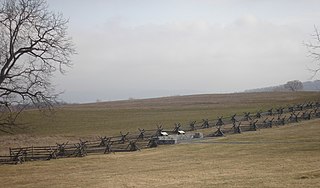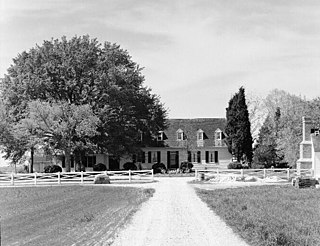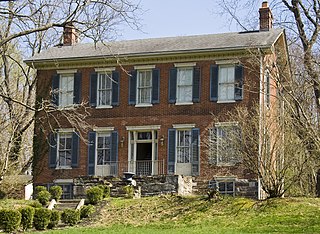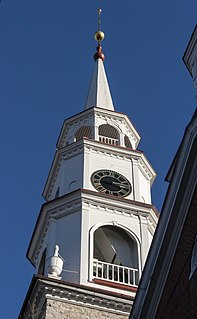Monocacy National Battlefield is a unit of the National Park Service, the site of the Battle of Monocacy in the American Civil War fought on July 9, 1864. The battlefield straddles the Monocacy River southeast of the city of Frederick, Maryland. The battle, labeled "The Battle That Saved Washington," was one of the last the Confederates would carry out in Union territory. The two opposing leaders were General Jubal Early, fighting for the South, and General Lew Wallace, fighting for the North.

Antietam National Battlefield is a National Park Service-protected area along Antietam Creek in Sharpsburg, Washington County, northwestern Maryland. It commemorates the American Civil War Battle of Antietam that occurred on September 17, 1862.

Buckeystown is an unincorporated community and census-designated place (CDP) in Frederick County, Maryland, United States. As of the 2010 census the population was 1,019. Buckeystown Historic District and Buckingham House and Industrial School Complex were listed on the National Register of Historic Places in 1982. Carrollton Manor was listed in 1997. Former Congressman Roscoe Bartlett lives on a farm in the town.

Arcadia is a historic house located between Frederick and Buckeystown, Maryland. Erected about 1790, the house overlooks Monocacy National Battlefield. The house was extensively altered in the late 19th century and now possesses an elaborate balconied tower. The interior was also extensively updated at that time.

Snow Hill is a manor house located south of Laurel, Maryland, off Maryland Route 197, in Prince George's County. Built between 1799 and 1801, the 1+1⁄2-story brick house is rectangular, with a gambrel roof, interior end chimneys, and shed dormers. It has a center entrance with transom and a small gabled porch. A central hall plan was used, with elaborate interior and corner cupboards. The original south wing was removed and rebuilt, and the home restored in 1940. The Late Georgian style house was the home of Samuel Snowden, part owner of extensive family ironworks, inherited from his father Richard Snowden. and is now owned and operated by the Maryland-National Capital Park and Planning Commission as a rental facility.

Beall's Pleasure is a historic home located in Landover, Prince George's County, Maryland, United States. The original owner of the land was Colonel Ninian Beall. He helped establish the first Presbyterian Church in Prince George's County. It was built in 1795 as the summer home of Benjamin Stoddert who later became the first Secretary of the Navy.

Grahame House, Graham House, Mansion House, Graeme House, or Patuxent Manor, is a historic home located at Lower Marlboro, Calvert County, Maryland. It is an 18th-century original 1+1⁄2-story brick shell laid in Flemish bond with a steeply pitched gable roof. Later alterations have included the purchase and removal of the fine paneling throughout the house to the Henry Francis du Pont Winterthur Museum. Charles Grahame, for whom the home is named, was associated with Frederick Calvert, sixth Lord Baltimore, through Grahame's brother, David Grahame and with Thomas Johnson, first elected Governor of the State of Maryland, through Grahame's son.

Larkin's Hill Farm is a historic home at Harwood, Anne Arundel County, Maryland, United States. It is a 1+1⁄2-story gambrel-roofed brick house with a 20th-century wing. In 1683 the estate served as a temporary capital of Maryland. John Larkin, an early Quaker settler in the area, later operated an inn here as a stopping place on the first regular postal route in Maryland, which ran from St. Mary's City to Annapolis. The present brick house was built during the ownership of Lord High Sheriff of Annapolis Captain John Gassaway, the grandson of pioneer politician Colonel Nicholas Gassaway, shortly after his acquisition of the property in 1753.

Anne Arundel County Free School is a historic school building at Davidsonville, Anne Arundel County, Maryland. The first Free School of Anne Arundel County was established by an Act of the General Assembly of colonial Maryland in 1723. It was built somewhere between its contractual date of 1724 and 1746 when it was under full operation with John Wilmot as schoolmaster. The existing abandoned building is 49' x 18', and consists of six rooms on two floors. It was built "as near the center of the county as may be, and as may be the most convenient for the boarding of children." The county then included what is now Howard County. It remained in operation until 1912 when the movement toward consolidation forced the closure of many early school buildings. It is the only surviving schoolhouse erected in Maryland in response to the Maryland Free School Act of 1723.

Sarum is a historic home located at Newport, Charles County, Maryland. The oldest extant part of the house was built in 1717 by Joseph Pile on or near the site of his grandfather's 17th century house. It was a box-framed hall and parlor dwelling, 32 by 18 feet. A shed was added in 1736; later in the 1800s the ends were extended and new walls of brick were constructed giving the house its present dimensions. Sarum was patented to John Pile in 1662, and remained in the ownership of the Pile family until 1836. It is one of Maryland's finest small Colonial dwellings.

The George Markell Farmstead, also known as Arcadian Dairy Farm and the Thomas Property, is a historic home and farm complex located at Frederick, Frederick County, Maryland, United States. It consists of brick house built about 1865, a brick smokehouse, a bake oven, two stone domestic outbuildings, an ice house, a springhouse, a frame stable, a frame chicken house, a mid-20th century guest house, and various sheds and outbuildings. Nearby is a large gambrel-roofed concrete block barn. The main house has combined Greek Revival and Italianate stylistic influences. The once large Markell dairy farm, with its lane to the Ballenger Creek ford of the Monocacy River, served as the primary approach route to the battlefield by Confederate troops during the July 9, 1864 Battle of Monocacy during the American Civil War.

The Linganore Farm is a historic home and farm complex located at Frederick, Frederick County, Maryland, United States. The main house is a large two-story brick dwelling dating from the 1850s-60s and showing influence of the Greek Revival and Italianate styles. The property includes the ruins of a brick smokehouse, a stone root cellar and a two-story brick secondary house dating from the early 19th century. Across from the house is the site of the Linganore Mill, which was located on the east bank of the Monocacy River. In front of the house is a terraced lawn defined with large boxwoods. In 1891, the farm was converted to a resort known as the Linganore Hills Inn.

The Amelung House and Glassworks is a historic home located at Urbana, Frederick County, Maryland, United States. It is a two-story, late-Georgian brick home on a stone foundation built about 1785. The property once had the New Bremen glassworks built by Johann Friedrich Amelung after he came to Maryland in 1784; no above-ground remains of the factory remain. Fine examples of New Bremen glass work may be seen at the Metropolitan Museum of Art in New York City; the Corning Museum of Glass in Corning, New York; and Winterthur Museum in Winterthur, Delaware.

L'Hermitage Slave Village Archeological Site is an archaeological site near Frederick in Frederick County, Maryland. The location, within the boundaries of Monocacy National Battlefield, was the site of l'Hermitage Plantation, founded about 1793 by the Vincendière family. The Vincendières are believed to have been former Haitian landowners who had fled the Haitian Revolution to the Catholic-leaning state of Maryland. L'Hermitage was notable during its time for its size, brutality and for the large number of slaves on the property.

The Old Mill Road Bridge is a historic bridge near Rocky Ridge, Frederick County, Maryland, United States. The bridge spans Owens Creek southwest of Rocky Ridge on Old Mill Road. It is a Pratt half-hip through truss structure in a single span 69 feet (21 m) long and 16 feet (4.9 m). It was built in 1882 by the Pittsburgh Bridge Company, Pittsburgh, Pennsylvania.

The Frederick Historic District is a national historic district in Frederick, Maryland. The district encompasses the core of the city and contains a variety of residential, commercial, ecclesiastical, and industrial buildings dating from the late 18th century to 1941. Notable are larger detached dwellings in the Queen Anne and American Foursquare architectural styles of the late 19th and early 20th centuries The churches reflect high style architecture ranging from Gothic and Greek Revival to Richardsonian Romanesque and Colonial Revival. The east side of the district includes the industrial buildings.

Hitt's Mill and Houses, also known as Pry's Mill, Valley Mills, Hitt House, is a historic home and mill complex located at Keedysville, Washington County, Maryland, United States. It is a five-story stone and brick structure built as a grist mill. The ground story and the first full story above ground level are constructed of coursed limestone; the upper stories are built of brick. Also on the property is a square log outbuilding with a hipped roof, a large frame bank barn, and part of a fieldstone barnyard fence. The mill and the Hitt house served as hospitals during and after the nearby Civil War Battle of Antietam.
The Wye Town Farm House is a historic home in Easton, Talbot County, Maryland, United States. It is of brick construction, one and one-half stories high and two rooms deep with a small one-story brick kitchen. A two-story addition was made in the 20th century. The original section of the house dates from about 1800.

Creagerstown is an unincorporated community in Frederick County, Maryland, United States. It is playfully known by its residents as "4 miles from everywhere" because of its situation at 4 miles (6.4 km) from Thurmont, Woodsboro, Rocky Ridge, and Lewistown.

Caves Valley Historic District is a national historic district near Owings Mills, Baltimore County, Maryland, United States. It is located in a natural upland valley encompassing about 2,100 acres (8.5 km2) along the North Branch of the Jones Falls and its contributing courses. It includes cultivated fields, pastures, woodlands, streams, housing clusters, and agricultural structures. The vernacular buildings are log, stone, and frame, reflecting the local materials and functional plans of rural locations in the 18th and 19th centuries.






















